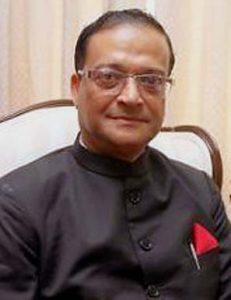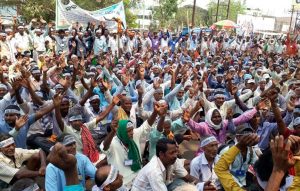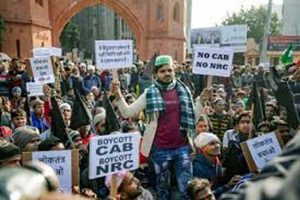 By Dr. Malay Mishra in Puri, April 6, 2021: Usually driving on busy roads one drives up a street only to find at the end a point beyond which the vehicle cannot navigate. It has to turn either right or left to continue its movement. The situation of India is similarly placed post-the Corona pandemic which still continues in its relapse even more virulently as one enters the era of de-globalization. This could also be called the tipping point when things are falling off the radar, the old order has crumbled and the new yet to emerge.
By Dr. Malay Mishra in Puri, April 6, 2021: Usually driving on busy roads one drives up a street only to find at the end a point beyond which the vehicle cannot navigate. It has to turn either right or left to continue its movement. The situation of India is similarly placed post-the Corona pandemic which still continues in its relapse even more virulently as one enters the era of de-globalization. This could also be called the tipping point when things are falling off the radar, the old order has crumbled and the new yet to emerge.
India thus passes through the pangs of a painful transition which observers have likened to the end of India’s globalization or liberalization phase started in the early 1990s by the Narasimha Rao government. While the pandemic displayed the fault lines of a decimated global economy which saw above all the accentuation of poverty and a humungous increase in the rich-poor divide throughout the world, India felt its pangs the most. With a burgeoning population in extreme poverty, which according to World Bank predictions figured beyond 80% of the national population, the Indian government has much to worry about to alleviate the poverty levels, reduce the inequality gap and provide for its masses with basic essential services such as healthcare, education and grassroots support as well as local infrastructure facilities for mobility, employment and skilling needs of its educated masses in both rural as well as urban sectors.
Rise in inequity and the social cost:
Ironically the pandemic saw a huge rise in the fortunes of billionaires throughout the world, while the bulk of the poor became poorer by several times. The Oxfam Inequality Report 2021 observed, inter alia, that” the world’s richest men’s wealth has gone up by more than $500 billion” and that “all billionaires’ wealth returned to pre-pandemic levels in 9 months while recovery of the world’s poorest could take a decade”. The US-based Pew Research Centre (PRC) in a report brought out on March 18, 2021 showed that 32 million Indians, those earning between $10 and $20 a day, have been pushed out of the middle class and joined the poorer segment while the number of poor with incomes less than $2 a day has gone up by 75 million. The Chinese government in January this year stated that they have completely eradicated poverty while the number of poor in India as per the PRC report far exceeded China at current rates.
Neo-liberalism and protest:
 The recent trend of the Modi government has been most pronounced in adopting a neo-liberal economic behavior. This has been symptomatised with mass protests erupting in several parts of India in protest against the government’s move towards privatization. In this perspective it is not difficult to understand the nearly four months-long farmers’ protest demanding the repeal of the three farm laws nor that of the million-plus bank employees all over the country in a call by the bank unions to protest the government’s move towards privatization of PSU banks.
The recent trend of the Modi government has been most pronounced in adopting a neo-liberal economic behavior. This has been symptomatised with mass protests erupting in several parts of India in protest against the government’s move towards privatization. In this perspective it is not difficult to understand the nearly four months-long farmers’ protest demanding the repeal of the three farm laws nor that of the million-plus bank employees all over the country in a call by the bank unions to protest the government’s move towards privatization of PSU banks.
Throughout the world the one economic phenomenon which stood out through the pandemic was erection of protectionist barriers and severe recession resulting in disruption in global supply chains. Thus countries were left to fend for themselves by adopting an ultra-nationalistic stance. From America’s Trump to Hungary’s Orban to Turkey’s Erdogan or Russia’s Putin or Philippines’ Duterte, every leader pitched his own territory to the exclusion of others.
However what has been most discernible in the Indian case was the government’s indifference towards providing enough economic stimulus to the marginalized and extremely vulnerable groups which had suffered the brunt of the misery inflicted by the pandemic. In a strange paradox, despite carrying a formidable burden of 80% population under extreme distress there has been a conspicuous move towards privatization and corporatization, symptoms of an “irreversible marketism”. Under the circumstances though Atmanirbhar Bharat sounded a good slogan during these stressful times, there have been systemic problems in implementing that into action, primarily because of the extreme vulnerability of a declining economy and second, with the manufacturing sector not performing properly the Indian economy has suffered irreversible damage.
Emergence of a minimalist state:
It is indeed a matter of great irony that under such trying circumstances the government should have adopted a ‘hands-off policy’. The PM’s message in this connection was most telling when he stated, “It is not the business of government to be in business”. Such an approach could have suited a stable economic order benefiting all social classes on an equal playing field but not with such lopsided and inequitable distribution of wealth and privileges in the society. Yet the government by making the mantra of privatization eloquent and beginning to sell off its vital; assets, viz. banks, airlines, PSUs, infrastructure, and envisioning a PPP approach towards important service related sectors such as healthcare and education (the New Education Policy could be read in this light) signaled a new India which was uncaring for its poor and needy. This could have enormous social implications and could reset the existing power relations in a big way. Coming along with the alleged discrepancies in treatment of social groups on the basis of their religious affiliation and the charges of human rights violations and curtailment of democratic credentials, the combination could be a lethal antidote to the development and growth paradigm.
Imperative of good governance:
‘Good governance’, a key imperative flagged by certain prominent economists who had earlier supported globalization but were now withdrawing their positions such as Amartya Sen, Jagdish Bhagwati, Raghuram Rajan, Kaushik Basu, Arvind Subramanian, Ankleswar Aiyar and Sankar Aiyyar have all advocated the merit of government intervention in reducing socio-economic inequities and championed the cause of corruption-free governance for last-mile delivery. It seems as if the Marxian doctrine of “greater accumulation of wealth at the top leading to greater accumulation of misery” is being retested in a post-Marxist age.
Power of the people and arrogance of the state:
 Famous Czech dissident and the first President of Czechoslovakia Vaclav Havel wrote a tract entitled “Power of the Powerless” in 1989 on the eve of the break-up of the Soviet Union where he called upon the people to unleash their power of protest at social repression. Thus was born the ‘Velvet Revolution’ and a new Czech state ushering in the power of the civil society and countless popular movements that were to spawn thereafter. As German political scientist Habermas famously put it, “excessive bureaucratization would invariably lead to the birth of an authoritarian state” and then only could the power of protest emanating from a strong civil society tamper the edges of that state which might have lost contact with the masses. India is in the same conundrum today.
Famous Czech dissident and the first President of Czechoslovakia Vaclav Havel wrote a tract entitled “Power of the Powerless” in 1989 on the eve of the break-up of the Soviet Union where he called upon the people to unleash their power of protest at social repression. Thus was born the ‘Velvet Revolution’ and a new Czech state ushering in the power of the civil society and countless popular movements that were to spawn thereafter. As German political scientist Habermas famously put it, “excessive bureaucratization would invariably lead to the birth of an authoritarian state” and then only could the power of protest emanating from a strong civil society tamper the edges of that state which might have lost contact with the masses. India is in the same conundrum today.
What we are witnessing is arrogant state power capturing all vital institutions and having its own will in the name of governance. After all democracy at the end of the day is a game of numbers and the party which takes the majority seats wields power in the Westminister system of government which India has adopted. Those numbers could therefore be accrued through any means and people could be fed on an ideological manoeuvring of the state, all to suit the agenda of the ruling dispensation. It is another matter that India’s democratic credentials are now being questioned by prominent organizations such as the V-Dem Institute of Sweden and Freedom House of USA. Not that it bothers the government though in right earnest it should, in addressing its human rights concerns and erosion of democratic values.
- (The author is a retired Ambassador and a doctorate in social exclusion.)



Leave a Reply
Be the First to Comment!